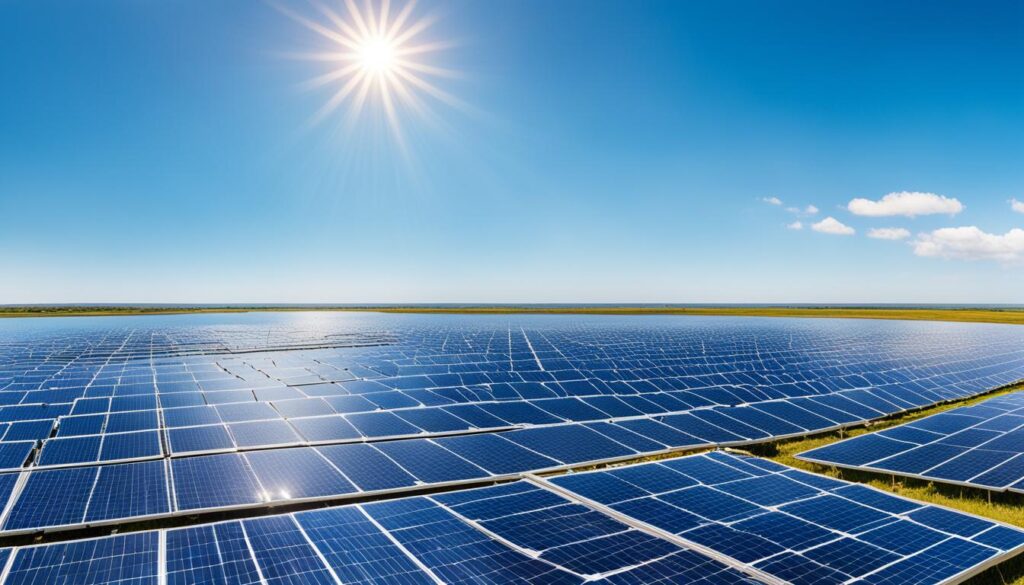Ramagundam is a town in Telangana, India. It is now the site of the country’s biggest solar farm. Called the Ramagundam Solar Power Plant, this project is a huge step forward for India’s renewable energy goals. It covers 100 MW and floats on the 500-acre balancing reservoir of the NTPC Ramagundam thermal power plant.
Key Takeaways
- The Ramagundam Solar Power Plant is India’s largest floating solar power project, with a capacity of 100 MW.
- The project is spread across 500 acres of the balancing reservoir of the NTPC Ramagundam thermal power plant.
- The Ramagundam Solar Power Plant showcases India’s commitment to renewable energy and sustainable development.
- The project aims to reduce the country’s carbon footprint and promote energy efficiency.
- The Ramagundam Solar Power Plant represents a significant milestone in India’s journey towards clean energy and green technology.
Unveiling India’s Largest Floating Solar Power Plant
The Ramagundam Solar Power Plant is a big step for India’s renewable energy path. It’s the country’s biggest floating solar power effort. This plant highlights how India is serious about using clean energy and lowering its carbon footprint.
Ramagundam Solar Power Plant: A Groundbreaking Achievement
Located on a 500-acre area on a reservoir, the 100 MW Ramagundam Solar Power Plant shows India’s strength in solar energy. It’s a floating solar power project that makes renewable electricity. This shows India’s goal of using sustainable and efficient energy sources.
Innovative Design and Advanced Technology
This plant uses top-notch photovoltaic systems and smart design ideas to catch the sun’s power. Its solar panels are on water, keeping the land free. India’s serious about using smart green technology.
Environmental Benefits and Water Conservation
It’s not just about making power. The plant also helps save water and protect the environment. It slows down the water’s loss to evaporation, saving water. Plus, its clean energy cuts the country’s environmental impact.

Exploring the Ramagundam Solar Power Plant
The Ramagundam Solar Power Plant stands out in India’s journey towards more renewable energy. It covers 500 acres around the balancing reservoir of the NTPC Ramagundam thermal power plant. Here, you’ll find the 100 MW project, which includes 40 blocks. Each block can produce 2.5 MW of solar energy.
Project Overview and Specifications
This plant is India’s big step forward in using renewable energy. It uses top-notch photovoltaic systems. With a 100 MW capacity, it’s the biggest floating solar power system in India.
Construction and Implementation Process
Building the Ramagundam Solar Power Plant took a lot of planning and hard work. The construction team used the latest technology and fresh ideas to solve many problems. They made sure the deployment of this sustainable energy source was a success.
Power Generation and Capacity Utilization
This power plant uses the area’s lots of solar energy well. It helps India lower its carbon footprint and promote clean energy. Its smart location and energy-saving steps let it make a lot of power. This makes it a top example of how to use green technology to help the environment.
Conclusion
The Ramagundam Solar Power Plant is a massive step for India’s renewable energy. It’s the biggest floating solar power project in the nation. This shows India’s strong push towards using solar energy more. At 500 acres, it’s not just about making clean renewable energy. It helps cut down on dirty air, uses less energy, and is efficient.
This plant also shows off India’s skill in new green technology. It uses the water from the NTPC Ramagundam thermal power plant. By doing this, it uses land and water better.
The Ramagundam Solar Power Plant stands for India’s progress in clean energy. It is a big part of India’s clean energy goals. Also, it encourages more work and new ideas in the solar energy field. Because of efforts like these, India keeps leading the way in battling climate change.
FAQ
What is the Ramagundam Solar Power Plant?
The Ramagundam Solar Power Plant is in India’s Telangana, in the town of Ramagundam. Covering 100 MW, it’s the biggest floating solar power project in the nation. It’s set on the NTPC Ramagundam thermal power plant’s balancing reservoir, spreading over 500 acres.
What is the significance of the Ramagundam Solar Power Plant?
This plant marks a big step in India’s journey towards renewable energy. Being the country’s biggest floating solar project shows India’s aim to use clean energy. It proves the country’s commitment to cutting down on harmful emissions.
What are the key features of the Ramagundam Solar Power Plant?
The plant is set in 40 blocks, each producing 2.5 MW of power. It uses topnotch photovoltaic systems and smart design. These things help it create more energy without hurting the environment.
What are the environmental benefits of the Ramagundam Solar Power Plant?
This plant aids in lowering India’s carbon footprint by making clean energy. Its location on a balancing reservoir is also a win for water saving. It supports good water usage practices.
What is the power generation capacity and utilization of the Ramagundam Solar Power Plant?
With a 100 MW capacity, it’s India’s top floating solar project. The plant works at full strength, helping a lot in meeting India’s renewable energy targets. It also cuts down on using traditional fuels.

